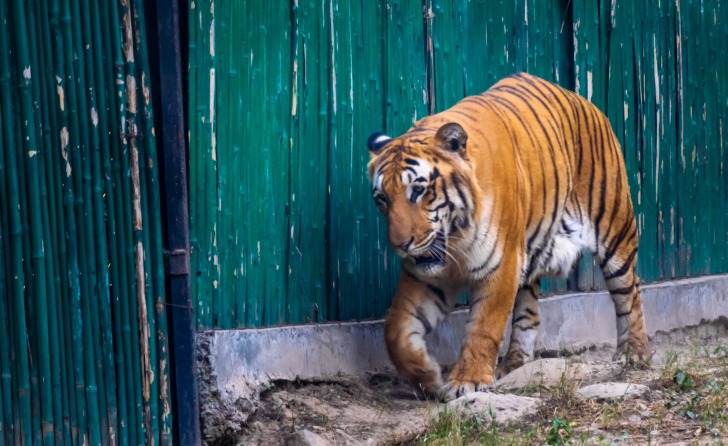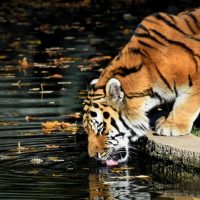I pondered for a while what to include on the best zoos and aquariums list for Delaware.
DE doesn’t have that many of its own, so it seems.
Most sources do mention animal centers in nearby states, such as New Jersey, Pennsylvania, and Maryland.
I chose to include wildlife refugees within the state of DE as an alternative when creating my list.
Contents
- 10 Best Zoos and Aquariums in Delaware (Or Near It)
- 1. Brandywine Zoo
- 2. Barn Hill Preserve
- 3. 3 Palms Zoo
- 4. Woodland Beach State Wildlife Management Area
- 5. Bombay Hook National Wildlife Refuge
- 6. Prime Hook National Wildlife Refuge
- 7. DuPont Environmental Education Center
- 8. Tri-State Bird
- 9. Delaware Riverfront Waterfront Adventure Aquarium
- 10. James Farm Ecological Preserve
- 10 Best Zoos & Aquariums in Delaware – Summary Table
- Delaware Safety Overview
- Frequently Asked Questions
10 Best Zoos and Aquariums in Delaware (Or Near It)
1. Brandywine Zoo
Brandywine Zoo has a notice on its website about the 2023 season.
It’s free admission until March 17 because of the colder temperatures this time of year.
On the other hand, the odds could be in your favor if it’s about 50 degrees F or more outside.
If you happen to be free on one of the warmer-cold winter days, you could save money.
The Brandywine Zoo in Wilmington, DE features the Red Panda, Andean Condors, chickens, and goats.
They also have barnyard animals you can “brush.”
You might want to contact the zoo directly for more information about “brushing” the animals.
For now, I know that the zoo provides education to interested students, including people who want to work with animals full-time someday.
Other animals you’d find at the Brandywine Zoo include the hyena, buffalo, bear, lion, and wolf.
There may also be condors and lemurs there, among others.
Keep in mind that animal relocation from zoos, sanctuaries, and wildlife refuges sometimes happens.
Still, this zoo has about 90 creatures in all for you to view and engage with.
90 might seem like a small number in contrast to other U.S. zoos, but it’s about the quality of treatment, not the number of creatures.
They seem to care about the animals they have.
That’s what I think matters the most.
I also get the impression this would be an excellent place for aspiring veterinarians to hang out.
I bet the people who volunteer here would get a favorable reference for future opportunities.
2. Barn Hill Preserve
Barn Hill Preserve has a presence in Louisiana and Delaware.
They’re about 19 hours away from one another, just so you know.
If you’re looking for “Sips with Sloths,” you’ll have to go to Louisiana for that.
It’s the opportunity to relax and enjoy some wine while hanging out with the sloth, which apparently is the (or one of the) slowest animals on earth.
At the Delaware Barn Hill location, you can swim with otters.
I have never heard of this being on anyone’s “bucket list,” but it’s a unique experience nonetheless.
It’s the first I have ever heard of a zoo offering the chance to swim with otters.
This same tour also allows you close-ups with kangaroos, an aardvark or sloth, and small reptiles and mammals.
It’s a climate-controlled pool with no chlorine that apparently accommodates Asian animals.
I can’t say that the experience at Barn Hill Reserve is what I would first think of when spending time with wildlife.
However, it sounds like a chance to interact with creatures you otherwise wouldn’t have in the state.
3. 3 Palms Zoo
3 Palms Zoo boasts about being Delaware’s only alligator exhibit.
That’s not hard to believe, knowing that this happens to also be one of the largest and only zoos in the state.
Besides the alligator, 3 Palms also has the Silver Fox, Eastern Coyote, llamas, geese, ducks, sliders, and cooters.
There also may be some mallards, herons, killdeer, tortoises, and more here when you visit.
One of the most unique aspects of the 3 Palms Zoo is that they admit to rescuing illegal animals.
Some of them have experienced abandonment by pet owners.
I’m not sure if Delaware would be my first location choice when it comes to zoos.
However, this state sure does provide some of the most unique experiences you’ll ever have.
4. Woodland Beach State Wildlife Management Area
The state doesn’t seem to have much of a description of the animals you can see at Woodland Beach or related wildlife areas.
The best resource you might have at this time is the pictures you see on Google Maps.
Keep in mind that this area is meant for hunting and fishing first and foremost, not for viewing animals.
According to Visit Delaware, it does encompass about 6,000 acres of land.
I found pictures of birds, turtles, fish, rabbits, ducks, butterflies, and more.
It may not be a place to take children, but animal enthusiasts and nature researchers would love it.
5. Bombay Hook National Wildlife Refuge
Bombay Hook is known for its remaining salt marsh, which they describe as one of the largest remaining in the Mid-Atlantic region.
Any animals you may spot here include ones you’d normally find inhabiting this environment.
It also includes freshwater wetlands.
I particularly recommend Bombay Hook for bird lovers.
There’s a list of what flying creatures you might find at this refuge on this page: https://www.fws.gov/refuge/bombay-hook/visit-us.
Some waterfowl you might see here include the black duck, pintail, American Widgeon, wood duck, green-winged teal, and more.
The U.S. Fish & Wildlife Service (FWS) has a list of the types of animals (especially birds) you might see here every month of the year.
You might occasionally spot a Bald Eagle or white-tailed deer here as well.
Some sections of Bombay park are designated as natural research areas.
Other sections are probably for hunting and fishing.
Stay safe and take caution when hiking, swimming, kayaking, sunbathing, or animal viewing.
6. Prime Hook National Wildlife Refuge
At Prime Hook, you’ll find the Rufa Red Knot, one of the birds that often feeds and nests here.
You’ll find a total of 245 species of birds at this refuge as of 2023.
Make sure you pay attention to the latest notices provided by the refuge.
For instance, they sometimes alert potential visitors of times when deer hunting will occur.
You can enjoy bird watching and animal viewing at Prime Hook just as much as you can at a zoo.
However, you need to take caution against getting shot.
It’s ideal for adults passionate about nature and animals.
I wouldn’t recommend it for children unless they stay by your side the entire time you’re there.
Aside from birds, you might also see a Peninsula Fox Squirrel, Horseshoe Crab, or other creatures.
7. DuPont Environmental Education Center
The DuPont Environmental Education Center (DEEC) welcomes the public to visit year-round.
It isn’t called a “zoo” in its title, but it does seem to operate like one.
This center houses the American Bald Eagle, Wood Duck and river otters, turtles and dragonflies or beavers – and maybe more.
It all depends on what kind of animals show up.
The DEEC focuses also on education about conservation and making a safe place for humans to enjoy nature.
Besides animals, they also work toward preserving land and watersheds.
This park encompasses about 2,000 acres of land.
This natural area hosts guided tours throughout the year.
In addition, they hold summer camp sessions on their grounds.
It seems like a more family-friendly place to visit than some of the refugees but may not be as interesting to extreme outdoor adventure enthusiasts.
8. Tri-State Bird
If you find an injured bird, this is one of the places in Delaware where you can bring it.
Tri-State Bird located in Newark, DE rescues about 2,000 flying species a year.
This includes cleaning up birds who’ve become victims of oil spills, contaminated by diseases, or infected by lead.
I think it’s an important community service that Tri-State Bird offers.
I don’t have any confirmation that they’re open to the public at this time.
However, they do have operation hours during the day listed on Google Maps.
I know Tri-State Bird does host events throughout the year.
Some of them are for fundraising, while others are open house events.
You may want to contact them via their website, by telephone, or on Facebook to find out if you can come to view the birds onsite.
Types of birds rehabilitated here include owls, bald eagles, and turkey vultures.
You can sign up for internships or volunteer at Tri-State Bird if you want.
That would be the best opportunity for interacting with the creatures they have onsite.
9. Delaware Riverfront Waterfront Adventure Aquarium
I snuck the Adventure Aquarium on the list even though it’s not technically in Delaware.
It’s a 40-mile drive from Wilmington, DE, and a 21-minute drive from the Philadelphia National Airport.
It has one of the largest water tank areas I have ever heard of – more than two million gallons.
These waters hold about 8,500 species, including Hammerhead and Silky Sharks, stingrays, sea turtles, and Blue Penguins.
They house more than 15,000 creatures overall.
The Adventure Aquarium offers the Shark Bridge and Tunnel attractions.
The Shark Bridge allows you the chance to walk only a few inches above the 21-foot-deep shark tank.
Look below and see a sand tiger, sandbars, and nurse sharks.
They have 550,000 gallons of water to swim around in.
The Shark Tunnel features an arched overhead aquarium you can walk under.
As you meander down this underground path, you will see not only the sharks but schools of fish.
It’s probably less “scary” than walking over the suspension bridge, but it’s not any less exciting probably.
Other sections of this aquatic center for animals you may want to see include the Sea Turtle Cove and the Penguin Park.
The Piranha Falls also sounds interesting, and so does the “Creature Feature” which showcases sea stars and sea cucumbers, snails, anemones, and more.
10. James Farm Ecological Preserve
The James Farm Ecological Preserve is located on Indian River Bay near the Bethany Church building on Cedar Neck Road.
This Ocean View nature center allows you to see wildlife right on the grounds of their marshland and forest habitats.
The James Farm Preserve has seven unique habitats that feature different creatures.
For instance, the meadow area has monarchs in it that migrate to and fro.
The maritime forest, however, is where the white-tailed deer and foxes are found.
This area also consists of loblolly pines and American holly trees in it.
You might also see some traces of hardwood trees throughout, such as the hickory oak or wild black cherry trees.
Another animal you might see throughout the James Farm Preserve includes the Ospreys, which are fish-eating birds.
You may also see horseshoe crabs and box turtles.
10 Best Zoos & Aquariums in Delaware – Summary Table
| Zoos & Aquariums | Address |
|---|---|
| Brandywine Zoo | 1001 N Park Dr, Wilmington, DE 19802, USA |
| Barn Hill Preserve | 34215 Peppers Corner Rd, Frankford, DE 19945, United States |
| 3 Palms Zoo | 1060 Vandyke Greenspring Rd, Townsend, DE 19734, USA |
| Woodland Beach State Wildlife Management Area | Smyrna, DE 19977, United States |
| Bombay Hook National Wildlife Refuge | 2591 Whitehall Neck Rd, Smyrna, DE 19977, USA |
| Prime Hook National Wildlife Refuge | 11978 Turkle Pond Rd, Milton, DE 19968, USA |
| DuPont Environmental Education Center | 1400 Delmarva Ln, Wilmington, DE 19801, USA |
| Tri-State Bird | 170 Possum Hollow Rd, Newark, DE 19711, USA |
| Delaware Riverfront Waterfront Adventure Aquarium | 1 Riverside Dr, Camden, NJ 08103, USA |
| James Farm Ecological Preserve | 30048 Cedar Neck Rd, Ocean View, DE 19970, USA |
Delaware Safety Overview
READ THE FULL REPORT: Delaware Safety Review
Safety Index:
- OVERALL RISK: MEDIUM
- TRANSPORT & TAXIS RISK: MEDIUM
- PICKPOCKETS RISK: LOW
- NATURAL DISASTERS RISK: LOW
- MUGGING RISK: MEDIUM
- TERRORISM RISK: LOW
- SCAMS RISK: MEDIUM
- WOMEN TRAVELERS RISK: LOW
Frequently Asked Questions
How many zoos are there in Delaware?
Some sources claim that there’s only one zoo in Delaware, which would be the Brandywine Zoo.
However, I would at least count two, including the Barn Hill Preserve because it operates like a zoo.
Many of the DE preserves also provide opportunities for observing wildlife.
How many animals do the Delaware Zoos have?
The DE zoos have a smaller cluster of animals than most wildlife centers.
For instance, the Brandywine Zoo may only have 90 creatures, while other zoos around the country have thousands.
Are the DE zoos open?
Some of the places where you can see animals in the state are open year-round.
Others are limited to spring, summer, and fall hours.
Is a wildlife preserve the same thing as a zoo?
A wildlife preserve and a zoo both allow public animal viewing.
However, zoos have a more organized, contained way of handling animals.











